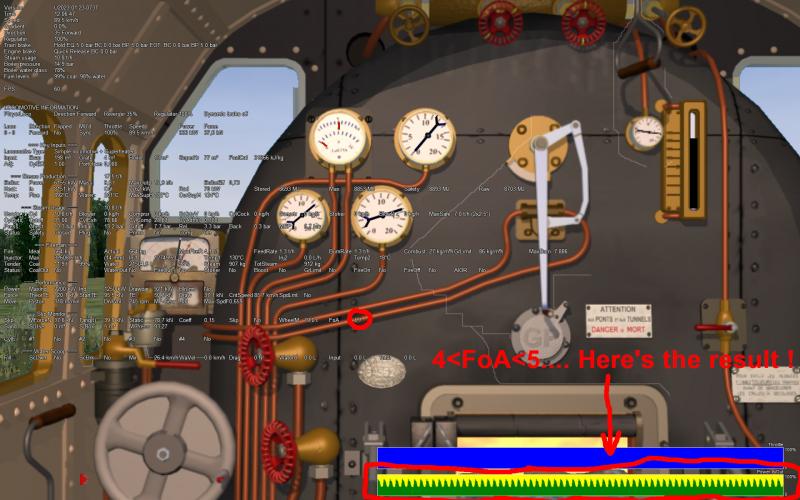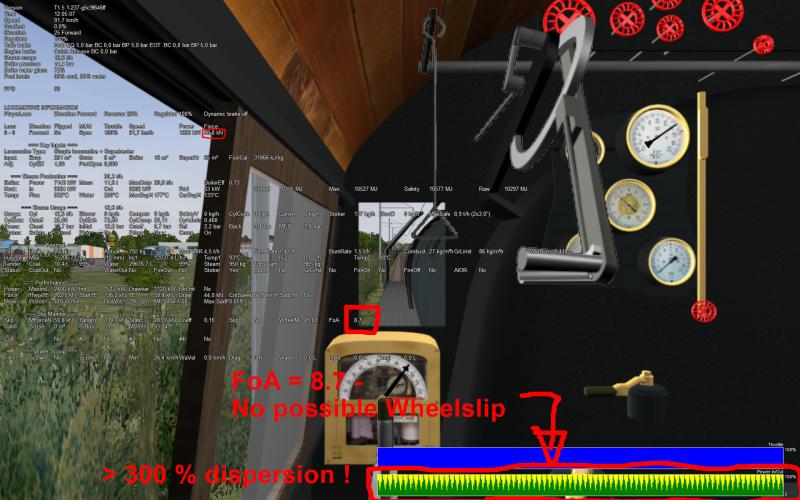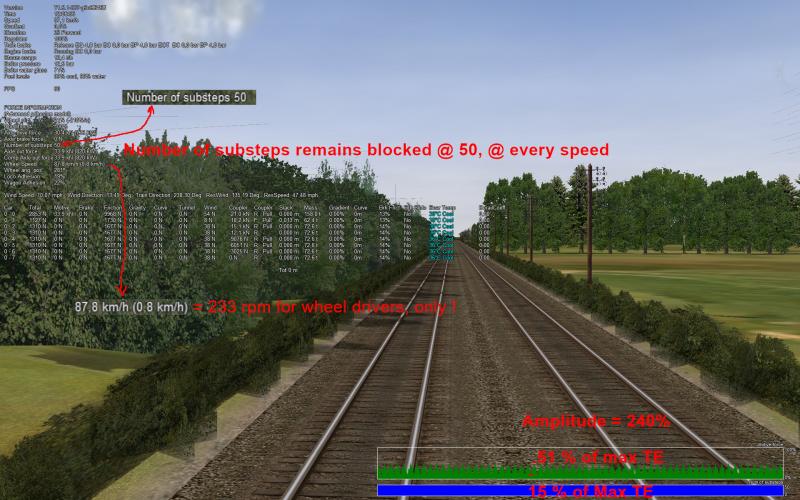Unstability of adhesion with Test version 1.5.1-237 With steam engines
#1

Posted 22 January 2023 - 10:38 AM
I have noticed that, with Testing version T1.5.1-237, downloaded on January 20th, adhesion of steam engines is seriously deteriorated. In consequence, tractive effort is perpetually oscillating, even for weak values (and without prealable wheelslip). Observations were the same for my whole batch of steam engines : with 1.5.1-173, no problem, and with 1.5.1-237, unstable tractive effort, with up to 25 % oscillations. No repercussions on Diesel or Electric engines.
Thanks in advance to cure this very unpleasant problem !
Cheers,
Jean-Paul
#2

Posted 22 January 2023 - 01:33 PM
After examination, I can confirm a bug has appeared in calculation of wheelslip only with steam engines. Wheelslip calculation seems never to have a stable value, even for tractive efforts widely inferior to adhesion limits. It doesn't seem to affect electric or diesel engines. If we list changes between 1.5.1-237 and 174 (previous testing version), we can notice these two changes :
33903e0e Adjustments to wheel slip
87638fa1 Steam slip
which are probably the source of these new problems.
Driving a steam engine is simply impossible with this "evolution" ! Moreover if you need high efforts !
Cheers,
Jean-Paul
#3

Posted 22 January 2023 - 04:44 PM
 Jean-Paul, on 22 January 2023 - 01:33 PM, said:
Jean-Paul, on 22 January 2023 - 01:33 PM, said:
You also might want to look at this thread as it talks about changes implemented, and todate no issues have been identified yet.
#4

Posted 23 January 2023 - 01:39 AM
 steamer_ctn, on 22 January 2023 - 04:44 PM, said:
steamer_ctn, on 22 January 2023 - 04:44 PM, said:
You also might want to look at this thread as it talks about changes implemented, and todate no issues have been identified yet.
Hi,
I've just tried latest unstable version U2023.01.23.0737, and problem remains : constant and cyclic unstability of tractive effort, even for a reasonable one (Here, 90 kN for 80 t of weight on drivers (1.65m diameter - 2 cylinders, simple expansion), i.e. 11,25 % of adhesive weight - widely below a normal adhesion @ 67 km/h - here, calculated value is around 19 % ). I don't contest the fact that, in reality, tractive effort is not a constant, following the different phases of distribution. But, I should say that, perhaps, too much is too much...
I add a screenshot to illustrate the problem.
Cheers,
Jean-Paul
#5

Posted 23 January 2023 - 01:53 AM
 Jean-Paul, on 23 January 2023 - 01:39 AM, said:
Jean-Paul, on 23 January 2023 - 01:39 AM, said:
I add a screenshot to illustrate the problem.
Does the locomotive actually slip? It has a low FoA, so depending upon the tractive force, it may exhibit slip in dry conditions.
The code model was tested against a "known" test locomotive, see the thread that I referred to and it appeared to match the "real" world expectations, see the information with the test model. The test model also had a FoA of 3.9, and could be made to slip at full throttle, and starting, so your model may be a bit slippery under some conditions.
If it can be shown that the test model is not aligning with the test expectations then I am happy to have a closer look at it.
#6

Posted 23 January 2023 - 02:19 AM
I should add that the problem becomes cartoonish at higher speeds. I've tested the same engine @ around 55mph, with an enforced adhesion by changing CK coefficients : I could observe that effort on axle could vary from 1 to 4, overating at maximum the OR MaxPower, by reaching 2700 kW (!) and lowering down to 700 kW (normal stabilized power, at this speed, is around 1500 kW). Calculation processes are permanent, even in this case, when I stabilized my speed... Really think it's a big problem !! I noticed that now, "number of substeps" appears in the dedicated window with steam engines (it was previously only the case with diesel or electric ones).. and here, number of substeps remains very high (more than 50), even with a constant speed.
Certainly, this innovation may seem to be amazing, at first glance, on very heavy trains, because it enhances slipping perception... I think it's absolutely awful in normal conditions of use (seen from an european point of view : lighter engines, lighter trains). My test engine, here, is a mixed-traffic one.. Problem is much more important with a speed locomotive, whose adheasion is limited... Undriveable is, I'm afraid, the more appropriated word. Of course, a steam engine is not easy to drive... but not impossible !
For now, that's clear, i give it up with testing versions, and stay to 1.5.1-174 !
Cheers,
Jean-Paul
#7

Posted 23 January 2023 - 02:57 AM
 steamer_ctn, on 23 January 2023 - 01:53 AM, said:
steamer_ctn, on 23 January 2023 - 01:53 AM, said:
The code model was tested against a "known" test locomotive, see the thread that I referred to and it appeared to match the "real" world expectations, see the information with the test model. The test model also had a FoA of 3.9, and could be made to slip at full throttle, and starting, so your model may be a bit slippery under some conditions.
If it can be shown that the test model is not aligning with the test expectations then I am happy to have a closer look at it.
Hi !
Well, well... FoA is only a coefficient, whose interest is only indicative, and concerns only uses of full regulator and cutoff openings. Whatever is the value of FoA, it has no importance if you only practice cutoff (or regulator) openings compatible with the adhesion. More, I don't say it's abnormal to slip... Never said that ! I have parametered hundreds of engines, and slipping is not, for me, an unknown concept.
The problem is that those cyclic variations of mentioned importance are unrealistic (or, at least, widely exagerated). Look at this screenshot, with a steam engine whose FoA is 4.7, i.e. between 4 and 5, no ?
I won't do any comments.
Cheers,
Jean-Paul
#8

Posted 23 January 2023 - 09:20 AM
This problem means a lot to me... So, I have tested the same engine that the first one, only modifying its weight, and its DriveWheelWeight. By this way, I obtained a FoA of 8.7. (Total weight = 215.5 mtons, Adh weight = 180 mtons)
Test reveals exactly the same problem as previous, i.e. a strong oscillation of tractive effort (more than 300 % dispersion), totally unrealistic, except with a totally staggered distribution. I precise that,otherwise, test engine has conserved same boiler, and cylinders that in its real version. Parameters are those of a real french SNCF 141-R.
I let you see, with this screenshot, which completly excludes the hypothesis of a wheelslip tendency. So, that's clearly the model of steam engine which is seriously affected by this modification, alas...
Cheers,
Jean-Paul
#10

Posted 23 January 2023 - 12:11 PM
 steamer_ctn, on 23 January 2023 - 11:59 AM, said:
steamer_ctn, on 23 January 2023 - 11:59 AM, said:
Hi !
Here are the files :
- 231-D-710 (FoA = 4.7)
- 141-R-1207 (FoA = 3.9 To get a FoA of 8.7, it needs to increase weight up to 115.5 t and ORTSDriveWheel up to 180 t.
Plus associated tenders : 22-C fits with 231-D, and 30-R-1207 with 141-R-1207.
Cheers,
Jean-Paul
Attached File(s)
-
 141R1207.eng (43.58K)
141R1207.eng (43.58K)
Number of downloads: 149 -
 30R1207.wag (7.31K)
30R1207.wag (7.31K)
Number of downloads: 141 -
 231D710_chain.eng (33.79K)
231D710_chain.eng (33.79K)
Number of downloads: 139 -
 T22C529_SNCFchain.wag (5.29K)
T22C529_SNCFchain.wag (5.29K)
Number of downloads: 134
#11

Posted 23 January 2023 - 09:00 PM
 Jean-Paul, on 23 January 2023 - 12:11 PM, said:
Jean-Paul, on 23 January 2023 - 12:11 PM, said:
 Jean-Paul, on 22 January 2023 - 10:38 AM, said:
Jean-Paul, on 22 January 2023 - 10:38 AM, said:
I am a little bit confused as both of your screen shots show the Power In/Out rather then tractive effort.
Tractive effort (force) is found on the Forces Information HuD.
I have run a test with my test model at 100% throttle and 40% cutoff, with as set Drive wheel weight and also with weight increased to 2 x the actual. Both runs seem to show a similar tractive effort.
Also looking at the maximum and minimum values of "Axle Drive Force" at various speeds, which represents the input tractive effort of the locomotive, this appears to be within the same sort of bounds as shown in the graphs on the stock page displayed near the locomotive. So I can't see where TE is oscillating outside of the expected bounds.
So at the moment I can't see any issues with the TE calculations. I can't comment on the Power calculations apart from saying that I am unaware of any issues with them at the moment.
If I get time I will look at your ENG/WAG files and the power calculations when I get some time, however I will be away for a few weeks within the next few days, so it may not be for a while.
If you wish you can repeat my tests with my test model, and if you identify any issues using it I might be able to have a quick look at it.
#12

Posted 24 January 2023 - 12:21 AM
 steamer_ctn, on 23 January 2023 - 09:00 PM, said:
steamer_ctn, on 23 January 2023 - 09:00 PM, said:
I am a little bit confused as both of your screen shots show the Power In/Out rather then tractive effort.
Tractive effort (force) is found on the Forces Information HuD.
I have run a test with my test model at 100% throttle and 40% cutoff, with as set Drive wheel weight and also with weight increased to 2 x the actual. Both runs seem to show a similar tractive effort.
Also looking at the maximum and minimum values of "Axle Drive Force" at various speeds, which represents the input tractive effort of the locomotive, this appears to be within the same sort of bounds as shown in the graphs on the stock page displayed near the locomotive. So I can't see where TE is oscillating outside of the expected bounds.
So at the moment I can't see any issues with the TE calculations. I can't comment on the Power calculations apart from saying that I am unaware of any issues with them at the moment.
If I get time I will look at your ENG/WAG files and the power calculations when I get some time, however I will be away for a few weeks within the next few days, so it may not be for a while.
If you wish you can repeat my tests with my test model, and if you identify any issues using it I might be able to have a quick look at it.
Hi !
Of course, I use extended HUD to do my tests... And I can't show, without a video, how TE varies, but if we are logical, if Power oscillates, TE = PE/speed oscillates also.
Then, no solution... Your test model works as good as possible, and mine no, because they are wrong, probably.
Anyone else could perhaps do the same test, and tell us if he sees the same problem ?
Cheers,
Jean-Paul
#13

Posted 25 January 2023 - 05:38 AM
Well, I did the test, with your model and consist.
No particular comments about your .eng file, except that's a more simple one than mines. You don't use improvements like "ORTSCylinderBackPressure" or "ORTSCylinderInitialPressureDrop", but I don't think it modifies the test.
My comments are as following :
- At low speed and wide opening of CutOff (up to 60 %), weak oscillations of TE, no wheelslip tendance (but adhesion is set to very high values for a large wheel locomotive - 30 % @ start, 19 % @ 50 mph)
- When speed increases, by lowering CutOff to respect abilities of boiler, relative oscillations become more and more consequent (in relative terms).
- Like the screenshot illustrates it, @ 55 mph, Tractive Effort varies from 15 to 51 % of its maximal value, i.e. a 240 % dispersion (=(51-15)/15).
- Number of substeps, which is 1 in the same conditions with 1.5.1-174 (without your modification) remains blocked at 50, for the whole duration of test. That means processor calculates continuously. Having a "big" computer, that's not a problem for me, but I wonder what could be the result with a weak PC configuration, on a "very busy" scenery.
- At 55 mph, rotation speed of wheels is around 233 rpm. Knowing that oscillations increase with rotation speed, it would be interesting to test for speeds > or = 300 rpm, frequently reached with high-speed engines.
No more comment to do.
I join an explicite screenshot.
Cheers,
Jean-Paul
#14

Posted 25 January 2023 - 08:28 AM
Turning to your eng file for the 141R, I have modified it to properly reflect the number of driving and carrying axles, 4 and 2 respectively. It very closely matches the theoretical max TE when starting. 45.1K actual against 45.8K theoretical. I feel that it may be slightly down on power. According to its wiki entry it should produce about 2890HP at 50 mph but so far I have only reached 2700 at that point. I feel that may well depend on controller settings
#15

Posted 25 January 2023 - 09:55 AM
 copperpen, on 25 January 2023 - 08:28 AM, said:
copperpen, on 25 January 2023 - 08:28 AM, said:
Turning to your eng file for the 141R, I have modified it to properly reflect the number of driving and carrying axles, 4 and 2 respectively. It very closely matches the theoretical max TE when starting. 45.1K actual against 45.8K theoretical. I feel that it may be slightly down on power. According to its wiki entry it should produce about 2890HP at 50 mph but so far I have only reached 2700 at that point. I feel that may well depend on controller settings
Hi !
Thank you very much for your test ! I am reassured if you consider these variations as compatible with our simulator. To be honest, although considering the approach as very valid, I was afraid that the intensity of the cyclical variations would undermine the normal functioning of the simulation. Being used to extended HUD, I have a direct reading on both efforts (axle and drawbar). I'm not so attached to extended HUD, but it remains very useful for parametering... And with new version, drawbar effort remains stable, so, it works !
About a slight weakness in drawbar power, I think that, effectively, discrete values for Cutoff are responsible. It's a "facility" when I give my instructions with my .eng files : it's easier to explain to "apprentice drivers" to "reduce a notch" of Cutoff than to suggest to search the exact value matching with boiler production...! Or, perhaps, that's a problem of quality of coal !! :rolleyes:
Once again, thank you very much for your help, and congratulations on this development !
Cheers,
Jean-Paul

 Log In
Log In Register Now!
Register Now! Help
Help







